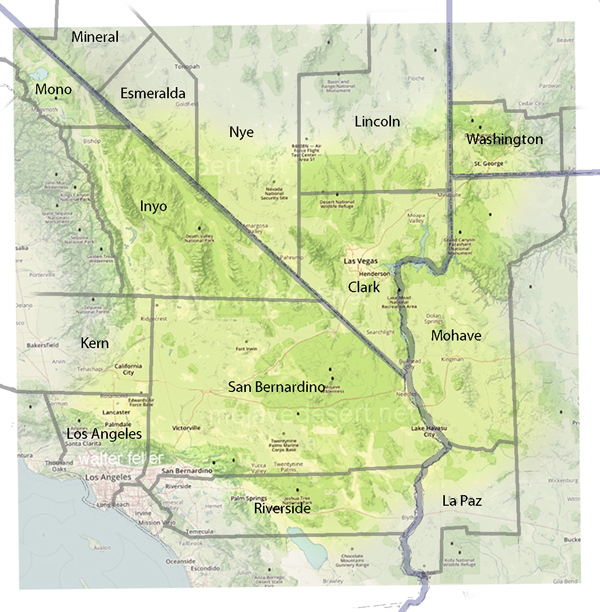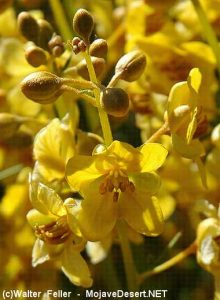from; Chap 39 – Mojave Desert – Pioneer Days in Kern County
by Arthur S. Crites – Los Angeles – The Ward Ritchie Press – 1951
THE Boundaries of the Mojave Desert are difficult to define. In Kern County, it commences at the easterly base of the Sierra Nevada Mountains. From there on it is a continuation of the desert as far east as Utah and also covers most of Nevada and Arizona and the southeasterly portion of California. So far as I know, however, only those portions of the desert in the easterly part of Kern County and the northerly part of San Bernardino County are designated on the map as the Mojave Desert.
In my youth the Mojave Desert was regarded by the traveler and prospector as a place to be dreaded and of genuine danger for travel, both in the winter and the summer seasons. In those days there were no mapped roads and in fact very little in the way of roads, usually just two ribbons through the sand where the teaming was being done.
While the springs and watering holes on the desert were reasonably well known, yet they were uncharted and distances were unmarked. There were, therefore, many tragedies recounted of prospectors and travelers dying of thirst in the summertime and of exposure in the winter season, and frequently bodies were not found until they were skeletons.

My Dad often made excursions to the Mojave Desert for prospecting purposes. He firmly believed until the last remaining years of his life that he was someday to find a fabulously rich
mine, so every now and then he would take a team and wagon, with his bed and cooking outfit and a barrel to haul water for himself and his team and make a prospecting trip to the desert.
Ordinarily, he was not gone over a month or two, but the last time he was in the desert for two years.
He, of course, became thoroughly acquainted with all the roads, trails, and springs and was well able to look out for himself and yet, he tells of one instance where he and his two companions almost lost their lives because of having gotten off the road which they should have taken and not discovering it until it was too late to turn back.
It was in the summertime and they left early in the morning, as most of the traveling was done at that time on the desert so that they might avoid the heat and also be sure of arriving at their water hole in ample time.
When they became aware of the fact that they had taken the wrong road they found themselves in a country with which they were totally unacquainted and had no knowledge where the next water was to be found.
As they were following something of a road and as it headed into some mountains in the distance, they felt sure they would find water when they got to these mountains so kept pushing on. The water they had with them gave out shortly after midday and from that time on both the horses and the three men suffered terribly from thirst. This, of course, slowed the pace of the horses. The tongues of all three men swelled badly.
Finally, Dad’s two companions became delirious. Dad always said he saved himself by placing a $5 gold piece underneath his tongue. This caused an additional flow of saliva. I have also read in desert lore that if you will cut a small piece of live greasewood and then peel it and place it on either side and underneath the tongue, it will materially aid the flow of saliva and delay the swelling of the tongue. As your thirst increases, one undergoes great torture and finally, the tongue swells so badly you are totally unable to talk and in time you become delirious.
The men finally arrived at a canyon in which they could hear the drip of water. It was quite some distance from where the road crossed the canyon. Dad unhitched the team and took them, together with the burro and also all the canteens which they had along, and started up the canyon toward the drip of the water. He finally found a small spring dripping into a barrel. He realized the danger of over-drinking to both the animals and himself. Therefore, he securely tied the animals before going to the water and then watered them with a bucket he had along and allowed them to drink only a bucketful at a time. He was also very cautious of the amount he himself drank. He then filled his canteens and retraced his steps to where his two companions were. He laid them both on the ground, covered their faces with a woolen blanket, and poured the water onto the blanket so that the only moisture they could get was what they could suck from the blanket. This was necessary to avoid over-drinking. He kept this up all night long. By morning they had sufficiently recovered to be able to speak and to take a little nourishment. It required all the next day, however, before the two of them recovered fully.
They then found themselves in a bad dilemma as they did not know where they were, or whether to attempt to follow the old wagon trail further or turn around and go back. They finally decided upon the latter but retraced their steps mostly during the night and early morning hours.
It was certainly a very narrow escape. Dad always had many stories to tell of the other instances which he knew had happened, of tragedies and near tragedies which had occurred on the desert.
I also had a chat at one time with a Mr. Fairbanks, who for many years ran a small hotel at Shoshone in Inyo County.
He had participated in many rescues on the desert and also in the finding of many who had not been rescued, all of which rather closely resembled the tales which Dad used to relate.
I also knew of an instance of two miners who had spent years mining on the Mojave Desert and were acquainted with all roads and trails and watering places. They had gone to town for supplies, traveling by night. The next night they attempted to return and took what they thought was a shortcut. They got mixed up in some unexpected washes and erosions and did not reach camp until three o’clock the following afternoon. Their tongues were swollen so
they were unable to speak but did reach camp before they became delirious. They saved their lives by sucking cold coffee through a woolen blanket.
One time I spent thirty days in Death Valley. It was in April and the weather was quite pleasant, but I was genuinely tortured by thirst. While I had plenty of good water, it would not quench my thirst. Every swallow was delicious, but each swallow called for another one, and no matter how much I drank the thirst continued.
Each day I went to the spring and got into a barrel full of water and stayed in an hour or more, with the hope this would help to relieve the inordinate demand for moisture. It did help, but very little. I finally took refuge in an old mining tunnel and for four days ate and drank nothing except cold tomatoes. This eventually alleviated the intense desire for moisture.
We never left camp that we did not take with us three or four canteens of water. We had a little Ford pickup that we used in traveling around the territory. This was before the days of good roads.
At that time the roads were nothing much more than wagon wheel tracks through the sand and, of course, there were no maps. It was fortunate I was with one who thoroughly knew Death Valley and where every wagon track led to. However, we never left the pickup, even to be gone only an hour, that we did not take a canteen of water with us and usually the water was all
gone by the time we got back to the car. The real cause of the inordinate thirst was the excessive dryness of the atmosphere.
Today there are, of course, excellent roads properly marked and excellent accommodations in Death Valley. It is a genuinely pleasant place to which one can make a trip in the winter and early spring, and also a place to avoid in the summertime.

To me, the desert has always been a place of great charm. There are beauties to be seen everywhere and the desert flowers are unsurpassed in beauty.
The many carvings from erosion are often as magnificent and as lacy as the carvings on the cathedrals of Europe and the formations caused by these erosions are of many colorings, making a genuinely inspiring sight to view.
In addition to all of the above is the ever-present haze on the desert. All are inspiring to one who loves the great outdoors. The greatest inspiration, however, is to spend a night in the desert, out underneath the stars. To me, there is nothing more moving. You have heard of the beauty which filters down through tinted window panes. That is nothing compared to the inspiration which comes to one when spending a night in the desert, out underneath the great dome of Heaven. It certainly makes one feel that there is a great God overall.